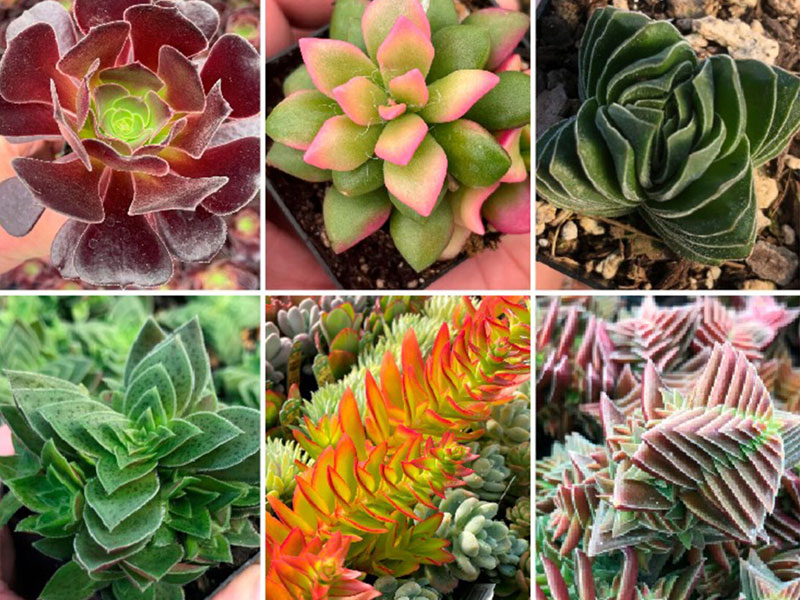These popular plants offere easy care, interesting looks and fun colors
Ann Patterson, houseplant buyer at Portland Nursery, has been collecting succulents for a long time.
“They’re interesting looking with lots of different textures,” Patterson said. “You can fit a lot of them into a small space and they’re slow-growing, so they don’t take over the house.”
While tropical foliage remain the most popular houseplants, succulents appeal to many different people. “They’re the potato chips of houseplants — you can’t just buy one,” Patterson said.
And the number of available varieties has continued to grow. “Even when I started working here eight years ago, the variety was smaller,” Patterson said. “Now, it’s not that difficult to find something I’ve never seen before, which always keeps it interesting.”
Keeping track of trends
Nicole Forbes, education and events director at Dennis’ 7 Dees Landscaping and Garden Centers in Portland, agreed that succulents great entry points for getting into houseplants because they take up less space than foliage plants, and they’re often more affordable.
“When I was a kid, I had pet rocks and sea monkeys, those things that started to turn me into a naturalist and appreciate the outdoors,” Forbes said, adding that succulents can play a similar role for kids now.
But, while they have the reputation of being easier to grow, Forbes believes there’s no shame in accidentally killing one by not providing the right amount of light, water or drainage.
“They are easy to kill, and that’s always one of the big challenges we have from a grower’s side,” Forbes said.
Forbes helps teach customers how to interact with a plant as it grows, such as replanting cuttings from stretched-out, curving succulents, or trimming off the brown dead leaves that form at the base.
“So many succulents get thrown out when they could just be trimmed back,” Forbes said. “They’re very resilient.”
New varieties prove popular
The “string of” succulents that look exactly like their name implies — string of pearls, string of dolphins, string of bananas, and more — are especially popular.
Patterson notes there’s even a string of watermelon.
“If someone finds a way to name a plant ‘string of’ something, it will be popular,” Patterson said.
“I just saw a ‘string of footballs,’ which I’ve never heard of before,” Forbes said, adding that people love collecting the “string of” varieties but struggle with them. She said these fussy plants don’t like to get their foliage wet but are often put in hanging planters. She suggests planting them in a way that allows a person to set them in a tray to be watered from the bottom.
Hanging succulents, in general, are popular, as are those with different colors, like the pink and red hues of Echeveria and Crassula jade plants.
Clark Weber worked from the ground up in the nursery industry, starting with digging water line ditches and eventually taking his career into the office of Little Prince of Oregon Nursery in Aurora, Oregon.
“Over time, my interest in the indoor succulent varieties ballooned and I became more and more familiar with what was unique and different, paying attention to sales trends, and well, simply what I was seeing around in independent garden centers and big box stores,” Weber said.
He was ecstatic to start overseeing succulent cuttings because he loves scouring availability lists for the coolest, rarest varieties, as well as popular, strong growers.
On his list are Adromischus, Aeonium, Anacampseros, cotyledon, Crassula, Delosperma, Echeveria, Gasteria, Graptopetalum, Haworthia, Kalanchoe, Pachyphytum, Sedum and more.
“Succulents display numerous characteristics that make them unique, including color, texture, growth pattern and, of course, blooms,” Weber said. “Personally, I have a fascination with Crassula, which displays highly geometric, fractal designs.”
One new variety for Little Prince this year is the Anacampseros telephiastrum ‘Variegata’.
“Its apple green rosettes have adorably pointed, tightly packed leaves in clumps with pink margins,” Weber said. “The color is especially pronounced when the plant is happily stressed by its environment, given full sun exposure and drought conditions.”
Weber thinks the future looks bright for houseplant sales in general, especially indoor succulents. “They have really caught on with younger generations,” he said. He thinks this is because they require low maintenance and little space, and they come with the instant gratification of owning a healthy plant.
Outdoor, indoor, online and in-person
Becky Sell, owner of Sedum Chicks in Turner, Oregon, offers hardy succulents that do well outdoors in the Pacific Northwest year round when placed in areas with good drainage or dry places like between the sidewalk and the street.
Sell said the climate here works well for succulents.
“In Oregon, we don’t have too high of highs or low of lows, so we are able to have so many types of plants and succulents,” she said.
The business also has a collection of tender succulents that can grow outdoors in containers during the summer and need to be brought inside in the fall.
“Those are popular and the amount of colors is spectacular,” Sell said. “I have quite a few in my own house — it’s like bringing the outdoors inside.”

